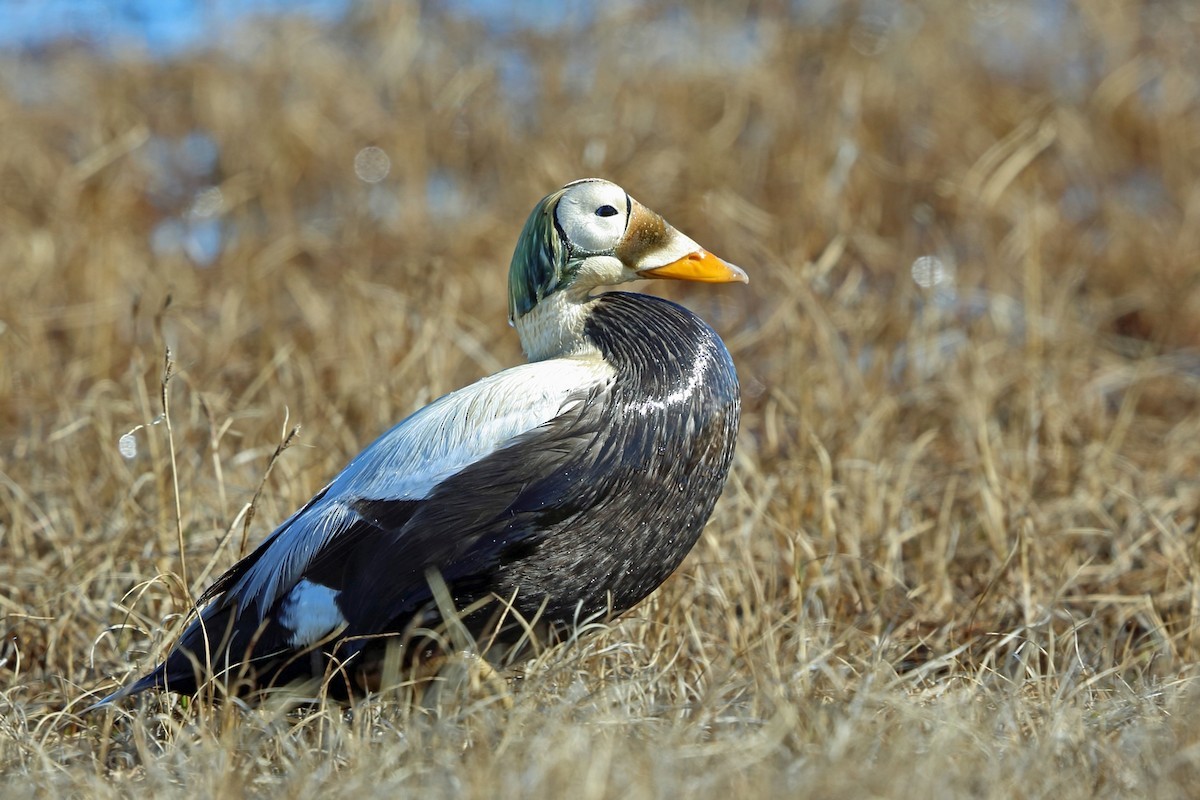Spectacled Eider
A species of Typical Eiders Scientific name : Somateria fischeri Genus : Typical Eiders
Spectacled Eider, A species of Typical Eiders
Botanical name: Somateria fischeri
Genus: Typical Eiders
Content
Description General Info
 Photo By Nigel Voaden
Photo By Nigel Voaden Description
The spectacled eider (pronounced /ˈaɪ.dər/) (Somateria fischeri) is a large sea duck that breeds on the coasts of Alaska and northeastern Siberia. The spectacled eider is slightly smaller than the common eider at 52–57 cm (20–22 inches) in length. The male is unmistakable with its black body, white back, and yellow-green head with the large circular white eye patches which give the species its name. The drake's call is a weak crooning, and the female's a harsh croak. The female is a rich brown bird, but can still be readily distinguished from all ducks except other eider species on size and structure. The paler goggles are visible with a reasonable view and clinch identification. Immature birds and eclipse adult drakes are similar to the female. The binomial commemorates the German scientist Johann Fischer von Waldheim. 
Size
41 - 81 cm
Life Expectancy
4-18 years
Nest Placement
Ground
Clutch Size
1 - 11 eggs
Incubation Period
1 brood
Number of Broods
23 days
Nestling Period
50 - 52 days
Feeding Habits
Spectacled Eider feed on aquatic insects, seeds, and plants on breeding grounds, using dabbling motions and tipping up in water. At sea, spectacled Eider dive to 250 feet for mollusks, crustaceans, and some fish. They forage for various prey, including snails, clams, and small crustaceans, swallowing underwater.
Habitat
Spectacled Eider's habitat encompasses North America's coastal wetlands and tundra, preferring marshy areas like western Alaska's Yukon-Kuskokwim Delta and the Beaufort Sea coast. Their nesting sites are typically on lake islands with dwarf shrubbery, while post-breeding, they utilize Norton Sound for molting and migrate to the Bering Sea's pack ice polynyas for winter survival.
Nest Behavior
Spectacled Eider starts nest building by forming a ground depression with her body, later lined with vegetation and down feathers after the third egg is laid. Egg-laying is followed by diligent incubation solely by the female, while the male typically leaves the breeding grounds.
Nest Characteristics
Spectacled Eider's nests are usually positioned near water on small islands, pond shorelines, or dry hummocks in wet meadows. The nests are made in sedges or dwarf shrubs, featuring a depression lined with grasses, sedges, and down feathers. They average 9.5 inches in diameter with an interior bowl of 5.5 inches across and 2 inches deep.
Dite type
Aquatic invertebrate eater
General Info
Feeding Habits
Bird food type
Behavior
Spectacled Eider are known for their unique social monogamy, exhibiting courtship displays such as head tossing and neck stretching in winter before selecting a mate. They maintain significant distance from other nesting pairs, yet occasionally form small nesting groups. The female oversees nest-building and chick-rearing solo, as males depart post-egg-laying. Spectacled Eider transition to the sea as seasons shift, with juvenile birds likely spending their first summer offshore. In winter, they aggregate in dense flocks for collective foraging and roosting, showcasing remarkable social cohesion amid harsh conditions.
Distribution Area
Currently, spectacled eiders occur along the coast of Alaska and easternmost Russia and into the Bering Sea. There are two breeding populations in Alaska and one in Russia. Historically there were more breeding individuals in Alaska but more recently the Russian population is much larger. Currently the United States population is an estimated 3,000-4,000 nesting pairs The spectacled eider molts at sea anywhere from 2 to 45 kilometers from the shore and north of 63°N. Since they are rarely seen outside of their breeding grounds, their wintering grounds in the Bering Sea were not known until recently with the help of satellite telemetry in 1995. 

 Photo By Nigel Voaden
Photo By Nigel Voaden Scientific Classification
Phylum
Chordates Class
Birds Order
Waterfowl Family
Geese Genus
Typical Eiders Species
Spectacled Eider